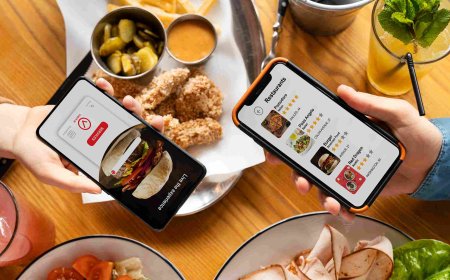How to Find the Best Tacos in Phoenix Like a Local
How to Find the Best Tacos in Phoenix Like a Local Phoenix, Arizona, may be known for its desert landscapes, sprawling suburbs, and scorching summers, but beneath the sunbaked surface lies one of the most vibrant and authentic Mexican food scenes in the United States. Tacos aren’t just a meal here—they’re a cultural institution, a daily ritual, and a point of pride for generations of families who’
How to Find the Best Tacos in Phoenix Like a Local
Phoenix, Arizona, may be known for its desert landscapes, sprawling suburbs, and scorching summers, but beneath the sunbaked surface lies one of the most vibrant and authentic Mexican food scenes in the United States. Tacos aren’t just a meal here—they’re a cultural institution, a daily ritual, and a point of pride for generations of families who’ve passed down recipes through decades. Whether you’re a newcomer to the Valley of the Sun or a long-time resident looking to deepen your culinary knowledge, learning how to find the best tacos in Phoenix like a local is about more than just following Yelp rankings. It’s about understanding neighborhood dynamics, recognizing the subtle signs of authenticity, and knowing where to look beyond the tourist traps.
The truth is, the best tacos in Phoenix aren’t always in the fanciest storefronts or the most Instagrammed spots. Often, they’re tucked into unassuming strip malls, parked in quiet side streets, or served from a window with no sign at all. This guide will walk you through the exact steps locals use to uncover hidden taco gems, the best practices for evaluating quality, the tools and resources that matter most, real examples of legendary spots, and answers to the most common questions. By the end, you won’t just know where to eat—you’ll know how to think like a Phoenix taco connoisseur.
Step-by-Step Guide
Step 1: Understand the Regional Taco Varieties
Before you start hunting, you need to know what you’re looking for. Phoenix’s taco scene is deeply influenced by its proximity to northern Mexico—particularly Sonora, Sinaloa, and Chihuahua. This means you’ll encounter distinct styles that differ from the tacos you might find in Los Angeles or Chicago.
Al pastor is a staple, often cooked on a vertical spit (trompo) and sliced thin with pineapple. It’s juicy, slightly sweet, and smoky—perfect on a soft corn tortilla with chopped onion and cilantro.
Barbacoa is slow-cooked beef, traditionally from the head, simmered until tender and shredded. Look for it served with consommé on the side for dipping.
Carnitas is pork that’s been braised in its own fat, then crisped. It’s rich, savory, and often found in both tacos and tortas.
Carne asada is grilled, marinated steak—usually flank or skirt—cut into strips. It should be charred at the edges, tender in the center, and never dry.
Pollo (chicken) tacos are often marinated in adobo or chipotle and grilled. Avoid places where the chicken looks gray or rubbery.
And don’t overlook fish tacos, especially in the summer. While not native to northern Mexico, they’ve become a Phoenix favorite thanks to coastal influences and fresh Gulf seafood.
Knowing these styles helps you ask the right questions and recognize quality. A local won’t just say “I want a taco”—they’ll specify “I need al pastor with pineapple, on corn, no lettuce.”
Step 2: Avoid Tourist Zones and Focus on Neighborhoods
Phoenix is a city of distinct neighborhoods, each with its own culinary identity. The best tacos are rarely found in downtown Phoenix, Scottsdale, or Tempe’s main drags—places packed with chains and overpriced “Mexican fusion” concepts.
Instead, head to areas with high concentrations of Mexican-American families:
- South Phoenix – The heartland of authentic Mexican cuisine. Look along 16th Street, Van Buren Street, and near the historic Barrio Logan district.
- West Phoenix – Areas like Buckeye Road and Grand Avenue are home to generations-old taquerias with loyal followings.
- Glendale – Especially along Grand Avenue and 59th Avenue, you’ll find family-run spots that have been serving since the 1970s.
- El Mirage and Surprise – Often overlooked, but these growing suburbs have quietly developed some of the most consistent taco joints in the metro area.
Locals know to avoid places with English-only menus, plastic tables, or fluorescent lighting. Instead, look for places where the staff speaks mostly Spanish, the menu is handwritten, and the clientele is predominantly Mexican or Mexican-American.
Step 3: Look for the Telltale Signs of Authenticity
There are subtle, almost invisible cues that locals use to judge a taqueria before they even order. Here’s what to watch for:
- Multiple tortilla warmers – A sign they make or receive fresh tortillas daily. Look for stacks of warm, soft, slightly charred corn tortillas—not the pre-packaged, stiff ones.
- Visible cooking stations – You should be able to see the grill, the trompo, or the pot of barbacoa. If the kitchen is hidden behind a wall, it’s a red flag.
- Handwritten signs – Especially in Spanish. A place that uses digital menus or glossy printouts often prioritizes aesthetics over authenticity.
- Long lines at lunchtime – Not a tourist line. A line of construction workers, nurses, or parents picking up dinner. If locals are waiting 15 minutes, you’re on the right track.
- Local license plates – If you see mostly Arizona plates from neighborhoods outside the immediate area, that’s a good sign people are driving specifically for the food.
Also, avoid places that offer “taco bowls,” “taco salads,” or “loaded nachos” as their main offerings. Authentic taquerias focus on tacos—usually two or three types—and keep the rest minimal.
Step 4: Ask the Right Questions
Don’t be afraid to ask. Locals often start conversations with the server or owner to learn more. Here are some phrases that open doors:
- “¿Cuál es su taco más popular?” (What’s your most popular taco?)
- “¿De dónde es su familia?” (Where is your family from?)
- “¿Hacen las tortillas aquí?” (Do you make the tortillas here?)
- “¿Qué lleva su adobo?” (What’s in your adobo?)
These questions show respect and interest. Many owners will respond with pride, offering you a free sample or recommending their “abuela’s recipe.”
Also, ask for recommendations beyond tacos: “¿Qué más recomiendan?” (What else do you recommend?) Often, the best salsa, guacamole, or aguas frescas are the hidden stars.
Step 5: Visit at the Right Time
Timing matters. The best tacos are made fresh daily, and many taquerias close early or sell out by mid-afternoon.
Best times to go:
- Lunch (11:30 AM – 2:00 PM) – This is when most taquerias are busiest and most likely to have fresh ingredients. It’s also when the carne asada is grilled to order.
- Early dinner (5:00 PM – 6:30 PM) – A quieter window to avoid crowds but still catch fresh batches.
- Avoid weekends after 7 PM – Many family-run spots close by 8 PM, and weekend nights are when chains and tourist spots thrive.
Some of the most legendary spots—like Tacos Chiwas or Tacos El Gordo—sell out of their best items by 3 PM. If you’re chasing a specific taco, arrive early.
Step 6: Taste with Purpose
When you get your tacos, don’t just eat. Observe.
- The tortilla – Should be pliable, slightly charred, and have a nutty, earthy flavor from masa. If it tastes bland or like cardboard, it’s store-bought.
- The meat – Should be moist, flavorful, and seasoned deeply. Overcooked or dry meat is a sign of low-quality cuts or improper technique.
- The salsa – There should be at least two: one red (often tomato-based), one green (salsa verde). Taste them separately. The red should be smoky and slightly sweet; the green should be bright and herbaceous with a kick.
- The toppings – Onion and cilantro should be fresh, not wilted. Lime should be served on the side—not squirted on for you. A true local always adds their own lime.
Pay attention to texture contrast: crispy edges on carnitas, juicy tenderness in barbacoa, the slight chew of al pastor. These details separate good tacos from unforgettable ones.
Step 7: Follow the Locals Online—But Not the Algorithms
While Yelp and Google Reviews are useful, they’re skewed by tourists and fake reviews. Instead, follow local food bloggers, Instagram accounts, and Facebook groups that are hyper-local.
Search for:
- “Phoenix taco crawl” on Instagram
- “Arizona foodies” on Facebook
- “Tacos de Phoenix” on TikTok
Look for accounts that post without filters, show real people eating, and tag locations with neighborhood names—not just “Phoenix.” Avoid influencers who post the same five spots every week. Real locals rotate.
Best Practices
Practice 1: Prioritize Consistency Over Virality
A taco spot might go viral on TikTok because of a colorful mural or a celebrity visit—but that doesn’t mean the tacos are good. The best taquerias in Phoenix have been around for 20, 30, even 50 years. They don’t need to be trendy. They just need to make the same great tacos every day.
Look for places that haven’t changed their menu, their logo, or their hours in decades. That’s the mark of a true institution.
Practice 2: Eat with Your Eyes Closed
One of the most powerful local tricks: close your eyes the first time you take a bite. Focus on flavor, texture, and aroma. Without visual distractions, you’ll notice if the meat is under-seasoned, if the salsa lacks depth, or if the tortilla is stale.
It sounds odd, but it works. Many locals do this instinctively. It’s how they separate the real deal from the copycats.
Practice 3: Bring Cash
Many of the best taquerias in Phoenix are cash-only. This isn’t because they’re outdated—it’s because they’re small, family-run businesses that don’t want the fees or complications of credit card processing.
Always carry at least $20 in singles. You’ll be glad you did.
Practice 4: Don’t Rush the Experience
Authentic tacos aren’t fast food. They’re slow food—crafted with care, served with pride. Take your time. Sit outside if you can. Talk to the people around you. Ask the owner about their story.
Some of the best taco experiences in Phoenix aren’t about the food alone—they’re about the connection. A grandmother who’s been making tortillas since she was 12. A father who drives 40 miles every weekend to get his favorite barbacoa. These are the stories that make Phoenix’s taco culture rich.
Practice 5: Respect the Culture
Phoenix’s taco scene is rooted in Mexican heritage. Avoid treating it as a novelty. Don’t order “taco Tuesday” specials at places that don’t have them. Don’t ask for “mild” salsa if you’re not used to spice—ask for “sin chile” instead. Don’t take selfies with the food like it’s a prop.
Be humble. Be curious. Be grateful.
Tools and Resources
Resource 1: Local Food Blogs
These are curated by locals who’ve spent years tasting and exploring:
- Phoenix New Times Food Section – In-depth features on hidden gems, interviews with owners, and seasonal guides.
- Arizona Republic’s “Eats” Column – Written by longtime food critic Catherine Toth Fox, who focuses on authentic, family-run spots.
- Local Eats AZ – A blog dedicated solely to Mexican food in the Valley, with maps and detailed reviews.
Resource 2: Google Maps with Local Filters
Use Google Maps, but don’t rely on ratings alone. Search for “taqueria” and filter by “Open now” and “Most reviewed.” Then, look at the photos. Are they taken by locals? Are there photos of the tortilla station? Are the people in the photos dressed for work, not for a night out?
Also, use the “Photos” tab and sort by “Most recent.” If a place has photos from the last week, it’s likely still active and popular.
Resource 3: Facebook Groups
These are goldmines of real-time information:
- Phoenix Foodies – Over 80,000 members. Posts include “Where’s the best al pastor this week?” and “Just found a new barbacoa spot in Glendale.”
- Arizona Mexican Food Lovers – Focused on authenticity, with members posting receipts, handwritten menus, and stories.
- Phoenix Street Food & Food Trucks – Great for finding mobile vendors that rotate locations.
Resource 4: The Taco Trail Map (Community-Driven)
While there’s no official map, locals have created unofficial “Taco Trails” across the Valley. Search for “Phoenix taco trail map 2024” and look for PDFs or Google Maps shared by users with names like “PhoenixTacoAddict” or “SonoraNative.”
One popular trail includes:
- El Guero Canelo (South Phoenix)
- Tacos Chiwas (Glendale)
- Tacos El Gordo (West Phoenix)
- La Cocina de Doña Rosa (Phoenix)
- El Nopalito (Glendale)
These are not ranked—they’re just spots that locals return to again and again.
Resource 5: Podcasts and YouTube Channels
For deeper dives:
- “Taco Talk Arizona” Podcast – Weekly episodes featuring interviews with taqueria owners from across the Valley.
- “Phoenix Eats with Maria” YouTube Channel – No filters, no edits. Just Maria walking into taquerias, ordering, and eating with her family.
Real Examples
Example 1: El Guero Canelo – South Phoenix
Founded in 1991 by a family from Sonora, El Guero Canelo is a Phoenix institution. The original location on 16th Street has no signage—just a small awning and a line that snakes out the door. Their signature is the “Canelo Taco”—a simple combo of grilled carne asada, fresh cilantro, onions, and a house-made salsa roja that’s smoky and slightly sweet.
What makes it special? They grind their own corn daily. The tortillas are thicker than most, with a slight crust from the comal. The meat is marinated in a blend of garlic, cumin, and orange juice—something rarely seen outside Sonora.
Locals know to ask for “un poco de adobo extra” on the side. They’ll give you a little cup of the marinade to dip your tortillas in.
Example 2: Tacos Chiwas – Glendale
Named after the nickname for people from Chihuahua, Tacos Chiwas has been a Glendale staple since 2008. Their barbacoa is legendary—slow-cooked in banana leaves for 12 hours, then shredded by hand. It’s served with a side of consommé that’s so rich, you’ll want to drink it straight.
They also make their own queso fresco daily. It’s crumbly, milky, and slightly tangy—perfect on top of a carne asada taco.
What locals love: the owner, Don Miguel, still works the grill every day. He’s in his 70s. He doesn’t speak English. He doesn’t need to. His tacos do the talking.
Example 3: Tacos El Gordo – West Phoenix
Don’t be fooled by the name—this isn’t a chain. It’s a single-window taqueria with one table and a counter. But it’s packed daily. Their al pastor is cooked on a vertical spit that rotates slowly over charcoal. The pineapple is grilled alongside the meat, caramelizing into a sticky, sweet glaze.
They serve tacos in pairs—two small corn tortillas, not one large one. Locals say this is how it’s done in Mexico City: more texture, more flavor per bite.
Ask for “con todo”—it means with everything: onion, cilantro, salsa, and a squeeze of lime. They’ll give you a small plastic cup of house-made salsa verde that’s bright green and packed with tomatillo and serrano.
Example 4: La Cocina de Doña Rosa – Phoenix
Located in a quiet strip mall near 35th and Thomas, this spot has no website, no social media, and no menu posted outside. But if you ask around, you’ll hear whispers: “Doña Rosa makes the best pollo tacos in the city.”
The chicken is marinated in a secret blend of dried chiles, garlic, and a touch of orange zest. It’s grilled over mesquite, then chopped into bite-sized pieces. The tortillas are handmade and pressed on a wooden press.
Doña Rosa herself is in her 80s. She’s there every morning at 5 AM, preparing the meat. She doesn’t take tips. She doesn’t take photos. She just nods when you say “Gracias.”
This is the kind of place you find when you stop looking for the best—and start listening.
Example 5: El Nopalito – Glendale
Known for their fish tacos, El Nopalito uses fresh Gulf cod, lightly battered in a tempura-style batter made with beer and cornstarch. The fish is fried until crisp but tender, then topped with a cabbage slaw made with lime and a touch of crema.
What sets them apart? They use chile de árbol salsa—a fiery, bright red sauce that’s made from dried chiles, garlic, and vinegar. It’s not for the faint of heart, but locals say it’s the only salsa that cuts through the richness of the fish.
They also make aguas frescas daily: hibiscus, tamarind, and horchata. The horchata is made from scratch—rice, cinnamon, and sugar, blended and strained. No pre-mixes here.
FAQs
What’s the most popular taco in Phoenix?
Al pastor is the most popular, followed closely by carne asada and barbacoa. But popularity doesn’t always mean best. Many locals prefer the less common options like lengua (beef tongue) or cabeza (beef head) for their depth of flavor.
Are corn tortillas better than flour tortillas in Phoenix?
In authentic taquerias, corn tortillas are the standard. Flour tortillas are used mostly for burritos or in northern Mexican styles. If a taco joint primarily uses flour tortillas for tacos, it’s likely catering to non-Mexican tastes.
How much should I expect to pay for a taco in Phoenix?
A good taco costs $2–$3. If you’re paying $5 or more for a single taco, you’re likely at a tourist spot or a “gourmet” fusion place. The best tacos are affordable—because they’re made with care, not markup.
Do I need to speak Spanish to find good tacos?
No, but it helps. Many owners appreciate the effort. Simple phrases like “Gracias,” “¿Dónde está el baño?” or “Está delicioso” go a long way. You’ll often be rewarded with extra salsa or a complimentary churro.
Are food trucks better than brick-and-mortar taquerias?
Not necessarily. Some of the best tacos come from trucks, but so do some of the worst. Look for the same signs: fresh tortillas, visible cooking, local clientele. A food truck with a line of construction workers is better than a brick-and-mortar with no customers.
What’s the best time of year to eat tacos in Phoenix?
Every season is great. But summer is when many taquerias introduce seasonal specials: grilled cactus (nopal), fresh mango salsa, and chilled aguas frescas. Winter brings heartier options like barbacoa and menudo.
Can I order tacos for delivery?
Yes—but you lose a lot. Tortillas get soggy. Salsas separate. Meat cools down. If you must order delivery, choose a place that specializes in it and ask for the tacos to be packed separately from the salsa and lime.
Is there a taco festival in Phoenix?
Yes. The annual Phoenix Taco Festival happens every April in downtown. But locals say the real magic is in the everyday spots—not the festival booths. Use the festival to try new styles, but don’t rely on it for your best tacos.
Conclusion
Finding the best tacos in Phoenix isn’t about checking off a list or chasing trends. It’s about patience, curiosity, and respect—for the food, the culture, and the people who make it. The taquerias that endure are the ones that serve with heart, not hype. They don’t advertise. They don’t need to. Their reputation is built on the quiet consistency of a perfect tortilla, the warmth of a homemade salsa, and the pride of a family recipe passed down through generations.
As you explore Phoenix’s taco landscape, remember: the best spots aren’t the ones with the most likes. They’re the ones with the longest lines, the quietest corners, and the oldest hands behind the grill.
Start small. Visit one taqueria this week. Ask a question. Taste with intention. Let the flavors guide you. And when you find your favorite—don’t just eat it. Share it. Tell someone else where to go. That’s how the tradition continues.
Phoenix’s tacos aren’t just food. They’re a story. And you’re now part of it.





































